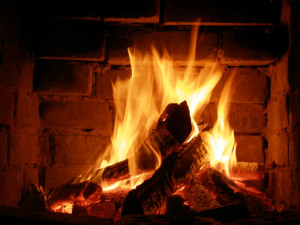Before you can sit back, relax, and enjoy the comfort and warmth of sitting in front of your fireplace, there is one thing everyone must do – start a fire! However, many homeowners may be starting their fires incorrectly; the wrong technique can lead to fires that burn sluggishly, need to be stoked frequently, or burn out prematurely.
The following steps can help you start a lasting fire in your fireplace. Next time you want to build a fire, try utilizing a few of our tips and see how it affects your fire performance!
1. Make sure you are using the right materials
All wood is not created equal; the type of kindling and firewood you use can have a major impact on fireplace performance.
- Kindling: While many homeowners use newspaper or dried grass for kindling, these materials burn so quickly that they often extinguish before the larger logs have had a chance to ignite. Instead, try using small, dry sticks of woods like pine, fir, or cedar. Although these softwoods are not recommended as the main fuel source for your fire they ignite quickly and burn steadily; this gives your larger logs a better chance to ignite and start burning before the kindling goes out.
- Firewood: When it comes to firewood, hardwoods are best. Woods like ash, elm, and oak burn at high temperatures for long periods of time. In order to maximize your fire’s performance, make sure that the wood has been seasoned for at least six months – if not longer – to remove the majority of the moisture content.
2. Open the damper
Any time the fireplace is in use – even if you are only starting to ignite your kindling –the damper must be open. Leaving the damper closed or only partially opening it can cause smoke and gas to build up in your home; this puts you and your family at greater risk for carbon monoxide poisoning.
3. Stack your firewood
How you stack your firewood in the fireplace can have a major impact on how your fire burns. Below are three popular methods of stacking firewood.
- Teepee: The teepee is the classic wood arrangement and is most often seen in outdoor fires and fire pits. However, if you have small enough logs this stacking method can easily be used inside! Lean firewood against itself to create a cone; place kindling around the bottom of the cone to ignite the wood. As the wood burns it will fall in on itself, creating a “core of heat” made up of hot embers and coals in the middle of the fireplace.
- Top down: The top down fire is one of the most unusual yet effective methods of stacking firewood. Wood is placed front to back in the firebox with the largest logs at the bottom and the smallest logs on top. Kindling is then placed among the logs as well as on top of the stack. Ignite the kindling and let the fire burn; as the smaller logs burn they will ignite the larger logs underneath, minimizing the amount of stoking that is needed.
- Log Cabin: For homes with large fireboxes, the log cabin method can create a roaring fire where the flames can get plenty of oxygen. Lay two split logs parallel to each other on the bottom of the grate, then place the next set of logs perpendicular to the first. Continue this pattern for two to three layers. Kindling should be placed in the bottom center; as the wood burns it falls to the middle, and new wood can be easily stacked on top.
